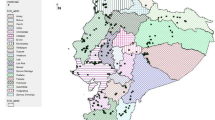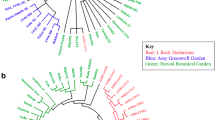Abstract
Sweetpotato [Ipomoea batatas (L.) Lam.] ranks among the seven most important food crops of the world. The International Potato Center (CIP) holds one of the largest sweetpotato (2n=6x=90) genebanks with more than 5000 cultivated accessions from America, Africa, Asia and the Pacific. This collection is clonally maintained because it comprises farmer-selected cultivars that have been asexually propagated for many years. Because of this, numerous duplicate accessions of the same cultivar are to be expected. Considering that almost 30% of the sweetpotato accessions assembled in this collection were from Perú, the first step to select a sweetpotato core collection was to identify duplicates in this group. Duplicate identification, using detailed comparisons of morphological characters and electrophoretic banding patterns of total proteins and esterases, reduced the number of Peruvian accessions in the collection from 1939 to 673. The number of duplicates of the same cultivar ranged from 1 to 99 accessions. A Peruvian sweetpotato core collection was selected to enhance the utilization of this germplasm. A total of 21 morphological descriptors were scored in all the different Peruvian cultivars. The unweighted pair-group method using an arithmetic average (UPGMA) determined the pairwise distance for members of distinct clusters based on these morphological descriptors. A core subset was selected considering the square root of the number of accessions for each Peruvian department and respective cluster, as defined by UPGMA. The original core collection consists of 85 accessions (12.6%) from all Peruvian departments, except that of Madre de Dios, where sweetpotato was never collected, and from all agro-ecological zones except Paramo, which has only 0.5% of the accessions of the entire collection. The sampling for this core collection was appropriate as determined by comparisons of means and frequency distributions for all morphological descriptors. Furthermore, this sampling was validated by the partial assessment of this sweetpotato germplasm for resistance to diseases and pests, tolerance to salt, storage root dry matter content, and vegetative period.
Similar content being viewed by others
Author information
Authors and Affiliations
Additional information
Received: 5 September 1998 / Accepted: 29 September 1998
Rights and permissions
About this article
Cite this article
Huamán, Z., Aguilar, C. & Ortiz, R. Selecting a Peruvian sweetpotato core collection on the basis of morphological, eco-geographical, and disease and pest reaction data. Theor Appl Genet 98, 840–844 (1999). https://doi.org/10.1007/s001220051142
Issue Date:
DOI: https://doi.org/10.1007/s001220051142




